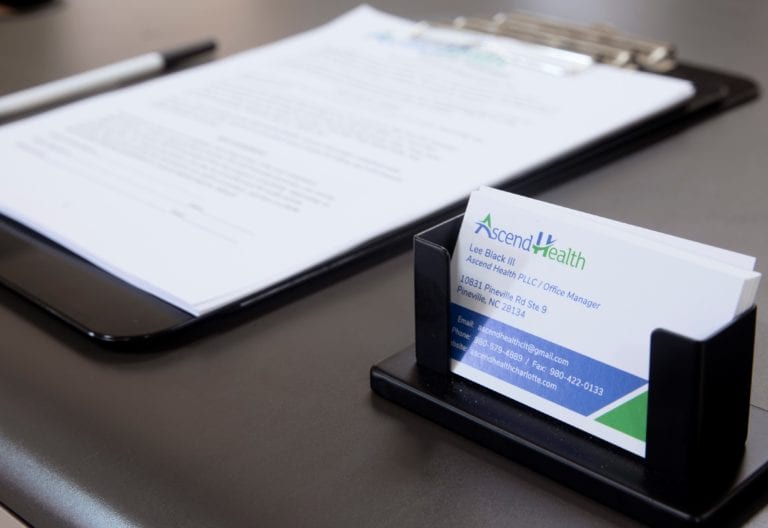If you are exploring treatment options for opioid use disorder, you may be preparing for your suboxone induction appointment. This important first step can help you or a loved one begin a path toward reclaiming physical and emotional well-being. At Ascend Health, we understand that each individual faces unique challenges, and we believe in offering comprehensive care that addresses your specific needs. Through supportive environments, tailored treatment programs, and individualized plans, you can find the support necessary for lasting recovery.
By learning more about what to expect during a Suboxone induction, you can feel more empowered as you start your treatment journey. Below, you will find a detailed overview of how Suboxone works, how best to prepare for your appointment, and how Ascend Health’s personalized programs can guide you from induction day through long-term recovery.
Understand the induction process
Before you or a loved one attends an induction appointment, it helps to have a basic understanding of the process. Suboxone induction is the introductory phase of a Medication-Assisted Treatment (MAT) plan in which a licensed provider monitors how you respond to your very first doses of Suboxone, an approved medication for opioid use disorder. This induction process is part of a bigger, three-stage treatment model that includes induction, maintenance, and the eventual transition toward recovery.
Purpose of induction
During induction, your clinician will carefully assess your level of opioid withdrawal, determine a safe dose of Suboxone, and evaluate how your body reacts to the medication. Suboxone typically contains two main components: Buprenorphine and Naloxone. This combination blocks the euphoric effects of opioids while reducing withdrawal symptoms and cravings, making it easier to focus on recovery. It should be used under close medical supervision and as part of a larger support system that includes counseling, peer support, and, optimally, a setting that fosters hope and healing.
Timeline of treatment
How long the induction phase lasts can vary from person to person. Some individuals may require multiple visits to determine the optimal dose and ensure stability. After this initial phase, you move into the maintenance stage. Most healthcare professionals suggest staying on a maintenance dose of Suboxone for anywhere between six and 18 months, depending on individual progress. Research has demonstrated that longer-term use often leads to better outcomes in achieving extended sobriety (Solas Health).
Importance of medical support
Attempting to manage opioid withdrawal alone can be overwhelming. A supportive environment and a specialized care team are vital for this process. Suboxone induction requires guidance from experienced professionals, so it is crucial to choose a provider who can adjust the medication to match your comfort level while ensuring your safety. At Ascend Health, our skilled team collaborates with you through every step of your induction, helping you navigate withdrawal symptoms and helping you set realistic, hopeful goals for recovery.
Recognize Suboxone’s role
You may wonder why Suboxone is so widely recommended for treating opioid use disorder. Its unique composition addresses withdrawal symptoms while preventing the full “high” that can come from other opioids. However, Suboxone alone is rarely enough—lasting recovery typically emerges from comprehensive care that addresses emotional, mental, and social factors as well.
Key medication components
- Buprenorphine: This partial opioid agonist helps manage cravings and mitigates the body’s response to quitting opioids. Buprenorphine binds to the same receptors as other opioids but does so in a way that diminishes the high while still relieving withdrawal.
- Naloxone: An opioid antagonist, Naloxone is included to minimize the potential for misuse. If someone attempts to use Suboxone improperly, Naloxone will block any euphoric effects from other opioids.
Role in MAT
Medication-Assisted Treatment (MAT) is regularly considered the “gold standard” in addressing opioid use disorder because it pairs medication with therapeutic interventions. Suboxone is a commonly chosen option in MAT because it allows for stabilization with fewer of the extreme highs and lows that come from abruptly stopping opioids. The medication eases the transition so you can engage more fully in therapy, peer support, and social rehabilitation strategies. Often, Suboxone is taken daily in a consistent dose, helping you prioritize emotional healing, job stability, and other core recovery goals.
Behavioral and peer support
Suboxone, as effective as it is in neutralizing cravings, cannot address every dimension of recovery on its own. Your success depends on pairing medication with counseling, group therapy, holistic approaches, or other supportive treatments that cover the psychological and social aspects of addiction. At Ascend Health, we use this dual approach—medical and therapeutic—to ensure you receive the comprehensive care required for a more peaceful and productive life free from the grip of opioid use.
Prepare for your appointment
Embarking on a Suboxone induction can feel intimidating. You may be uncertain about how to prepare, whether you’ll experience discomfort, or if you’ll miss work or family obligations. Fortunately, planning ahead can reduce stress. By following the guidelines below, you can arrive for your appointment feeling more informed and supported.
Wait period and mild withdrawal
Most healthcare providers recommend arriving at your Suboxone induction appointment in a mild state of withdrawal. You often need to abstain from opioids for about 24 hours—or even more—so that your body shows clear signs of withdrawal. This window is vital for preventing what is known as “precipitated withdrawal,” which can trigger severe and abrupt symptoms if you take Suboxone while other opioids are still active in your system.
- Short-acting opioids (Percocet, Vicodin): 12–24 hours of abstinence
- Long-acting opioids (Oxycontin): up to 36 hours of abstinence
Exact timing varies, so your professional care team will advise you based on your medical history (Workit Health). Sometimes, clinicians use scoring tools like the Subjective Opiate Withdrawal Scale (SOWS) or the Clinical Opiate Withdrawal Scale (COWS) to confirm you are properly in withdrawal.
Health and comfort measures
Withdrawal can feel similar to a severe flu, with body aches, sweating, nausea, and other uncomfortable symptoms. Stock up on gentle items that help reduce discomfort, such as electrolyte beverages, bland foods that are easy on your stomach, and warm clothing or blankets. Be sure to check with your provider about any over-the-counter medications or supplements you plan to use. Having these items ready at home can help you or your loved one focus on rest and avoid extra trips to the store.
Gather medical information
It is helpful to gather and document your medical history, including any previous treatments for addiction, mental health conditions, current medications, supplements, or past adverse reactions to certain drugs. Sharing complete and accurate medical details with your care team allows them to tailor your treatment plan more effectively. This transparency helps create individualized plans that address your unique challenges.
Communicate with support networks
Whether this is your first time in treatment or part of an ongoing journey, it often helps to engage family members, close friends, or peer-support communities. Let them know about your scheduled appointment and how they can help. If you feel comfortable, you might encourage them to learn about Suboxone induction and how it promotes safer withdrawal. Having even one supportive friend on standby for errands, childcare, or even a simple phone call can reduce stress.
Follow the day-of steps
Walking into your Suboxone induction appointment can feel both hopeful and nerve-wracking. Understanding the general flow of the day can calm any anxieties. While every program has its own protocols, most follow a similar sequence.
Step 1: Assessment
Your care team or prescribing provider will evaluate your withdrawal symptoms, often using specific scales to measure their severity. You will likely discuss how long you have been abstinent and describe any physical or emotional symptoms you are experiencing. At Ascend Health, our objective is to maintain a supportive environment, so you can share openly about any concerns without feeling judged.
Step 2: First dose
Once the provider confirms you are in mild withdrawal, you will likely receive your first dose of Suboxone. You typically place a Suboxone film under your tongue, letting it dissolve to be absorbed. Because Buprenorphine can take effect relatively quickly, many patients start feeling relief from withdrawal symptoms within about 45 minutes (Solas Health). However, durations may vary, and your clinic will monitor you closely throughout.
Step 3: Monitoring
After you take your initial dose, there will be a monitoring period—either in person or via telehealth. Your care team tracks:
- Changes in withdrawal symptoms
- Possible side effects
- Your overall level of comfort
If you need slight dosage adjustments, the provider may guide you through an additional or modified dose to ensure you reach a stable level of relief without risking unwanted side effects. This stage can involve regular check-ins so that any subtle shifts in physical or emotional status can be addressed right away.
Step 4: Next steps and prescription
Depending on the program’s specific policies, you might receive a short-term prescription of Suboxone to carry you through until your next check-in. Many providers require frequent appointments to ensure safety and continued progress. At Ascend Health, we also recommend concurrent therapy sessions—individual, group, or both—to help you develop healthy coping skills, reviewing how you are responding emotionally to treatment and everyday life.
Experience post induction benefits
Once you complete your initial appointment and settle into a stable dose, the focus typically shifts toward longer-term treatment goals. Suboxone can provide a consistent baseline that keeps intense cravings and withdrawal at bay, making it possible for you to commit more fully to counseling, work, family responsibilities, or other life changes.
Maintenance phase
Most doctors suggest maintaining a Suboxone dose for about six to 18 months, depending on individual needs and progress (Solas Health). Research shows longer-term use is associated with better outcomes when it comes to preventing relapse. During maintenance, you will continue to meet with your provider for dosage reassessments and have routine visits to gauge mental, emotional, and practical well-being. Many people find that consistent medication management for opioids helps them maintain stability over an extended period.
Counseling and therapy
Induction itself is not a standalone cure for addiction. The foundation built during the induction phase must be strengthened through therapy. This might involve traditional approaches such as Cognitive Behavioral Therapy (CBT) or more specialized, gender-specific, or trauma-informed methods. If you prefer something more holistic, you might add mindfulness-based techniques, art therapy, or other supportive methods. For individuals needing extra flexibility, you can also look into telehealth behavioral health support, enabling you to continue receiving therapy in a way that fits your schedule.
Peer groups and recovery networks
Beyond customized counseling, many individuals benefit from peer-based support groups. Whether these are in-person or online meetings, meaningful connections with others who share similar experiences can build accountability and understanding. People often learn new coping techniques and discover healthy ways to fill the void formerly occupied by opioid misuse. Such social networks can be invaluable when dealing with day-to-day stress or encountering triggers.
Progress monitoring
During your maintenance stage, your clinical team will monitor a variety of factors:
- Changes in physical health or mental well-being
- Emergence of co-occurring disorders
- Substance testing to confirm continued abstinence
- Effectiveness of therapy or counseling approaches
Adjustments may occur to optimize your program. If you feel cravings intensifying or mental health symptoms escalating, your provider can adapt your dose or therapy regimen accordingly. If certain tasks create new triggers, you can collaborate on strategies such as opioid withdrawal management or other supportive measures to get you back on track.
Choose Ascend Health services
Selecting the right care provider for a Suboxone induction is pivotal. The environment, staff expertise, and comprehensive services you receive can make all the difference in your recovery journey. Here is what makes Ascend Health a trusted choice for many individuals:
Tailored treatment programs
Ascend Health recognizes that every person has unique challenges shaped by personal history, health status, and family responsibilities. In acknowledgment of these variables, we develop individualized plans that target the specific obstacles standing in your way. From the initial induction phase to long-term aftercare, we offer a variety of avenues for your healing experience, including counseling, peer support, and advanced medical supervision. This approach ensures you have the support necessary for lasting recovery.
Specialized services
Beyond Suboxone induction itself, we offer a range of specialized services that can enhance your recovery experience. Many people value easy access to same day suboxone treatment if they need immediate help, or they may take advantage of evening suboxone appointments that allow them to fit treatment into their busy schedules. Additionally, for those with co-occurring psychiatric conditions, we have co occurring disorder import resources to ensure integrated care for both substance use and mental health issues.
Supportive environment
We strive to maintain a supportive environment that fosters optimism, trust, and understanding through each phase of recovery. Our team encourages open communication about side effects, personal challenges, and emotional struggles. This environment is particularly valuable for individuals who have hesitated to seek treatment due to shame or fear of stigma. By prioritizing empathy and respect, we help you feel comfortable enough to share honestly, which often leads to better treatment outcomes.
Compassionate staff and ongoing guidance
From your first conversation with our intake coordinators to your final aftercare sessions, you will be met with compassionate professionals ready to guide you at each step. Ascend Health’s staff is trained to anticipate roadblocks and offer real-life solutions, whether that means adjusting medication doses, coordinating with your insurance for coverage, or connecting you with strong peer support groups in your community. Our continuous support allows you to focus on long-term sobriety and personal growth without becoming overwhelmed by logistical hurdles.
Long-term commitment
Recovery is not a single event but a series of choices that reinforce healthy habits. Ascend Health remains committed to walking this journey alongside you for as long as necessary. Dedicated maintenance programs, relapse prevention measures, and ongoing educational resources help sustain the progress you have achieved. For example, if the time comes when you want to reduce or discontinue your medication, we can provide a supportive suboxone taper program and resources like suboxone maintenance therapy to ensure a safer transition.
Review frequently asked questions
Below, you will find five of the top searched questions and answers related to Suboxone induction. These will help you feel more prepared as you move forward in your own recovery journey.
- How long do I need to stop using opioids before induction?
You typically need to abstain from opioids for about 12–24 hours with short-acting opioids or closer to 36 hours with long-acting opioids. This waiting period ensures you are in mild withdrawal before receiving your first dose, preventing potential precipitated withdrawal (Workit Health). Your care provider can help you determine the exact timing. - What does it feel like to start Suboxone?
Many people notice a reduction in withdrawal symptoms and cravings within 45 minutes of taking their first dose (Solas Health). You might still experience some discomfort, but overall you can feel improved energy levels and fewer flu-like symptoms compared to unmanaged withdrawal. - How often do I have to see my doctor after induction?
In the early stages, appointments may be frequent so your provider can monitor dosage levels and potential side effects. Once you have stabilized, visits might be spaced out more. At Ascend Health, we offer flexible options like medication assisted treatment outpatient and telehealth mat services for those needing or preferring remote follow-ups. - Can I still work or attend school during induction?
In many cases, yes. While you may experience mild withdrawal before your first dose, once you begin Suboxone, many withdrawal symptoms subside. Some choose to schedule a day or two off to rest during the initial transition. Ascend Health can also arrange evening suboxone appointments, so you have flexibility in balancing treatment and responsibilities. - How long will I need Suboxone?
Each individual’s journey is different. Many doctors recommend staying on Suboxone for six to 18 months or longer for the best chances of preventing relapse. Should you decide to taper off eventually, a suboxone taper program can be a careful way to reduce medication levels and transition off safely.
Moving forward with confidence
Your Suboxone induction appointment is a worthwhile step in combating opioid use disorder. When you enroll in the program at Ascend Health, you benefit from a dedicated team that understands addiction’s unique challenges. Our tailored treatment programs, comprehensive care model, and individualized plans combine to create an environment that fosters true healing. From the first dose to long-term maintenance, we strive to give you the support necessary for lasting recovery.
We encourage you to reach out for more information about our compassionate services. If transportation, scheduling, or privacy are concerns, know that solutions like telehealth behavioral health support and confidential opioid treatment are available. Whether you require intensive outpatient therapy, inpatient support, or specialized options like outpatient detox management, Ascend Health’s caring staff stands ready to guide you. By learning more about your suboxone induction appointment in advance, you are taking a powerful, proactive step toward a healthier, more fulfilling future. We look forward to partnering with you and celebrating your progress as you move closer to lasting relief from opioid addiction.



